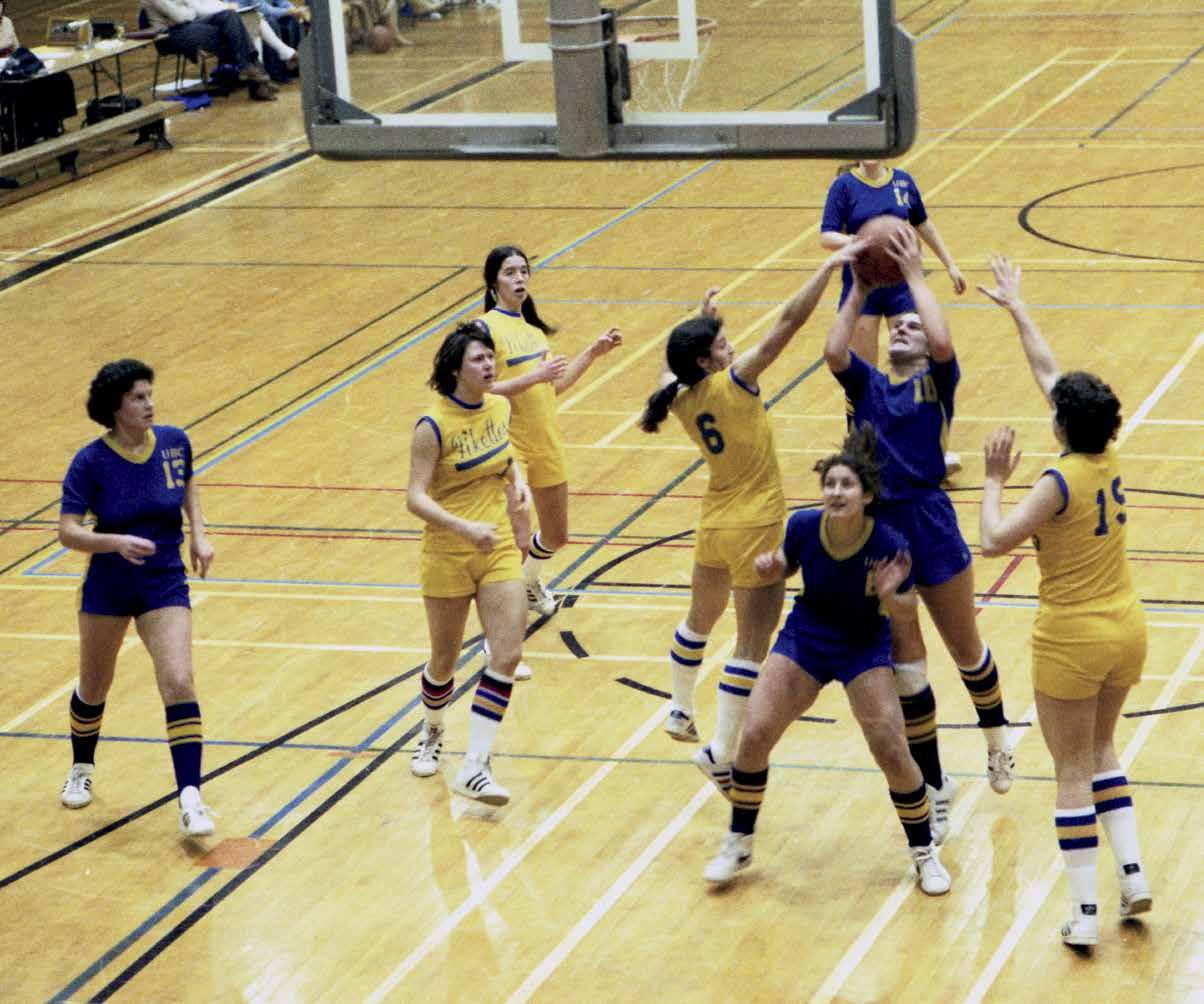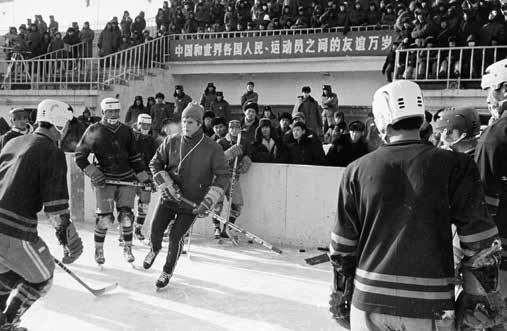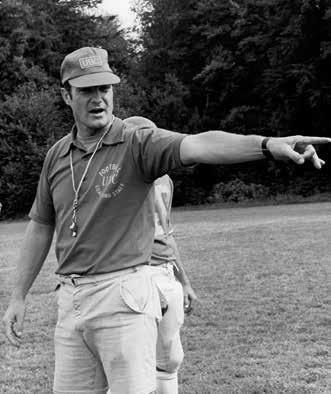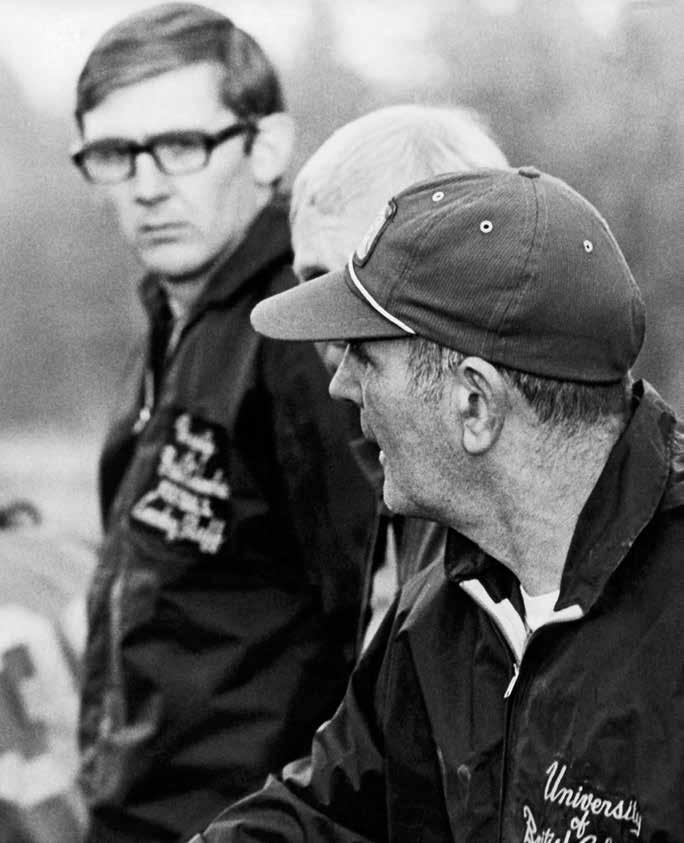
18 minute read
CHAPTER FIVE
CHAPTER 5
Equity Evolution
AS THRONGS OF SUMMER TOURISTS MINGLED OUTSIDE THE ICONIC BANFF SPRINGS HOTEL, DISCUSSIONS INSIDE HEATED UP AMONG DELEGATES TO THE 1969 ANNUAL GENERAL MEETING OF THE CANADIAN
INTERCOLLEGIATE ATHLETIC UNION. THE ISSUE WAS GENDER INEQUITY, A THORNY TOPIC BROUGHT
TO THE FORE BY A DETERMINED GROUP LED BY THE UBC SCHOOL OF PHYSICAL EDUCATION’S
MARILYN POMFRET (NÉE RUSSELL).
UBC’s 1969-70 women’s gymnastics team, coached by school faculty member Alena Branda, won the Western Canada Intercollegiate Athletic Association championship and competed in the first-ever national championships for women under the auspices of the newly founded Canadian Women’s Intercollegiate Athletic Union (CWIAU). The team included physical education student and 1968 Olympian Sandra Hartley (third from right). Hartley completed undergraduate and graduate degrees in the UBC school and later taught in the Faculty of Physical Education and Recreation at the University of Alberta.
With the support of delegates from McGill and the universities of Alberta, Toronto and Saskatchewan, Pomfret put forth a motion to the General Assembly to inaugurate national university championships for women. When CIAU president Maury Van Vliet called for a vote on the resolution, it was defeated on the grounds of prohibitive expense for both the organization and its member institutions. Although Van Vliet had verbally supported the resolution on behalf of the University of Alberta, he was compelled to side with the opposing majority who argued that the funding obstacles between their institutions and sending their women’s teams to national championships across the vastness of Canada could simply not be overcome. Facing an ethical dilemma, Van Vliet approached Russell following the adjournment and asked what she planned to do next. Perturbed, but undaunted, she refused to answer other than to say “you will have to wait to read tomorrow’s newspaper to find out.” What the sports sections reported the following day was that Russell and her supporters had pledged to inaugurate a new organization, the Canadian Women’s Intercollegiate Athletic Union (CWIAU). They made good on their declaration in the 1969-70 season when, with funding support from the federal Ministry of Fitness and Amateur Sport, women’s university teams from Vancouver to Montreal competed in invitational championships in volleyball, gymnastics and swimming. The following season, 1970-71, was the first year for true national
championships with teams and athletes qualifying via conference playoffs for the right to compete in the same three sports.
Basketball was added to the CWIAU championship menu in 1971-72, with UBC winning the inaugural event that year, its first of three consecutive national university basketball crowns. Coached by Norm Vickery, the 1971-72 team was built on a solid nucleus of returning veterans that had won both the WCIAA and Canadian Senior A championships the previous two seasons, including physical education students Joanne Sargent, Wendy Grant, Terri McGovern and Bev Barnes. The “Thunderettes” defeated Bishop’s University 63-32 in a 1972 national semi-final and then edged the University of New Brunswick 74-69 in the championship tilt, with Barnes scoring 20 points to lead UBC to its first-ever national women’s university championship.
Fittingly, Pomfret herself directed UBC to its first CWIAU national volleyball championship the following year. Led on the court by physical education students Betty Baxter and Maureen Fishleigh, UBC crossed four time zones to Acadia University in Wolfville, Nova Scotia to claim the CWIAU championship final of 1972-73, and then followed up with a repeat performance the following year before a hometown crowd at War Memorial Gym. UBC’s team again won national championships in 1976-77 and 1977-78, however, the latter victory would be UBC’s final championship win under the auspices of the Canadian Women’s Intercollegiate Athletic Union. Amalgamation talks began with the CIAU in 1977 as a result of Canadian attitudes towards women’s sport appearing to have progressed in the years following Pomfret’s bold leadership stance at the landmark meeting in Banff. Coached by Marilyn Pomfret, UBC’s 1973-74 women’s volleyball team won its second consecutive CWIAU championship at War Memorial Gym.

The 1980-81 women’s field hockey team, one of the five CIAU championship teams produced under Gail Wilson in her 17 years as coach.
Opposite page: 1977-78 UBC women’s basketball team in action at War Memorial Gym against the University of Victoria. UBC won back-toback CWIAU Titles in 1977 and 1978.

Some observers felt that the male-dominated CIAU had simply come to its senses on the principles of gender equity when, in 1977, it submitted a joint proposal with the CWIAU to the Ministry of Fitness and Amateur Sport for funding support for regular-season league travel. The proposal was approved and in the summer of 1978 the two organizations amalgamated to form a united national governing body for the administration and advancement of men’s and women’s university sport. Constitutional amendments were passed that called for equal representation on the Board of Directors as well as each institution receiving two votes within the CIAU General Assembly, provided it had two delegates in attendance to equally represent male and female interests. A resolution calling for a name change was also passed that summer, from the Canadian Intercollegiate Athletic Union to the Canadian Interuniversity Athletic Union, to help differentiate the modern organization from its archaic past.
As if to punctuate the leadership role that UBC’s School of Physical Education, and specifically Marilyn Pomfret, had played in achieving the evolutionary landmark, the 1978 UBC women’s field hockey team, coached by recently appointed physical education faculty member Gail Wilson, captured the first-ever CIAU women’s championship in any sport in the autumn of that year.
With Pomfret guiding a more energized women’s program and Bus Phillips continuing to lead the men’s division, UBC consistently produced national championship teams in both


Above: Opening ceremonies of UBC’s 1973 friendship tour at Peking Stadium. UBC was the first hockey team from the west to visit China.

Bob Hindmarch conducts a clinic with Chinese players on an outdoor rink in Harbin, China. In spite of bitter cold, thousands of curious locals flocked around the outdoor rink to watch.
men’s and women’s university sport. In addition, thanks to Osborne and Bob Hindmarch and their expansive network of international associates, the School of Physical Education led the way in creating other extraordinary opportunities for student-athletes, including an increasing amount of friendly competition against Asian teams both at home and in China and Japan. In the midst of the Cultural Revolution, UBC’s hockey team, coached by Hindmarch, undertook a historically significant diplomatic tour of China. Acting on a 1973 request from the Ministry of Foreign Affairs, Hindmarch and his players became the first foreign team to enter China, where they played friendly games throughout the country and conducted clinics in an effort to help Chinese sport officials popularize the game among youth and develop a national team program. In 1978, UBC’s women’s hockey team conducted a similar tour in Japan, becoming the first Canadian women’s hockey team to play in Asia. Partnerships with universities throughout Korea, Japan and Hong Kong soon followed.
By now it was overwhelmingly clear that one of the key objectives established by the founders of the School of Physical Education—enhancing its varsity athletics program—had been realized. Thanks to the steady recruitment of skilled and specialized coaches by Osborne, Phillips and Pomfret, UBC Thunderbird teams enjoyed almost universal success in both national and international competition. The one increasingly obvious exception, however, was the football team. In spite of the efforts of one of the most well-known and popular figures on campus, Frank Gnup’s teams posted just 10 wins against 38 losses between 1970 and 1973. Fortunes improved measurably, however, after Phillips approached West Vancouver High School teacher and coach Frank Smith, who took over as head football coach in 1974. With five years of professional playing experience in the CFL and 18 years of coaching experience on both sides of the Canada-US border, not to mention a master’s degree in education, Smith had the credentials and determination to turn the Thunderbird football program into a source of pride for the university and a jewel in its varsity crown. It would take just three seasons until his team captured a Canada West championship, and with it, the Hardy Cup trophy that had not resided on Point Grey for 14 seasons.
The fortunes of UBC’s track and field team also rose to national prominence in the 1970s, thanks in large measure to the appointment of English-born head coach Lionel Pugh, a graduate of the University of Wales and Carnegie College. From 1964 to 1987 Pugh taught in the school and served as head coach of the cross-country and track and field teams. Pugh had been an international competitor himself before becoming a UBC’s 1970-71 rugby team coached by Donn Spence was one of UBC’s best teams in any sport. Inducted into the UBC Sports Hall of Fame, the team was led offensively by physical education student Spence McTavish, who went on to a brilliant international career and later became a successful high school and UBC varsity coach. Physical education student Barry Legh was also an important fixture on this team, which won 21 of 22 games by convincing margins that year and claimed the McKechnie Cup and World Cup. After completing his MPE in the school, Leghhe joined the faculty and took over as rugby coach following the untimely death of Donn Spence in 1984.

Frank Smith took over as head football coach in 1974. Within just three seasons his team captured a Canada West championship and the Hardy Cup trophy that had not resided on Point Grey for 14 seasons. During his 20-year UBC coaching career, Smith led the Thunderbirds to the Vanier Cup four times and to victories in 1982 and 1986. His son Casey Smith, a 1986 physical education graduate, took over as head coach in 1995 and led the Thunderbirds to a Vanier Cup championship in 1997 after completing his master’s degree in the school.



Physical Education student and 1972 Olympian in track, Ken Elmer, is presented with the Bobby Gaul Trophy in 1974 by university president Walter Gage (left) and men’s athletic director Bus Phillips. In 1973 Elmer became the first UBC student to run the mile in under four minutes. While completing his master’s degree in the school he taught an undergraduate course in track and field and served as an assistant track coach under Lionel Pugh, whose other Olympians included Thelma Fynn (top right) and Penny May, pictured with Pugh (bottom right) at the 1972 Olympic Games. Physical education graduates Patti Loverock, Anne Mackie-Morelli and Rick Cuttell also went on to Olympic and international competition under the coaching of Pugh.

coach of the British track team for 11 years. He also served as an expert commentator for the British Broadcasting Corporation during coverage of national and international track and field events and wrote several books on the sport. Pugh coached UBC to four national titles and an astounding 25 Canada West championships. During his 23 years at UBC, 14 of his athletes represented Canada at the Olympic Games. An Olympic coach for Canada in 1972 and 1980, his knowledge and motivational manner contributed significantly to the success of a long list of UBC and international competitors, including School of Physical Education graduates Thelma Wright, Patti Loverock, Anne Mackie-Morelli, Ken Elmer and Rick Cuttell.
Soccer became a CIAU sport in 1972 and it took just two years for UBC to capture its first of many CIAU banners in the fall of 1974 under the coaching of former Glasgow Ranger Joe Johnson. Johnson, who coached UBC for 25 seasons and after whom the CIAU Player of the Year trophy was later named, led UBC to national championships again in 1984 and 1985. By this time volleyball was also well entrenched at university athletic departments across Canada. Head coach Lorne Sawula and future national team members Tom Jones and Merv Mosher led UBC’s men’s volleyball team to its second CIAU championship in 1976. Former team member and physical education graduate Dale Ohman subsequently took over as head coach and guided UBC to a third title in 1983.
Foreshadowing the phenomenal success that would later emerge for UBC swim teams, UBC’s women’s swim team was a formidable contender throughout the 1970s under coach Jack Pomfret, who guided his team to a CWIAU Championship in 1974, the first in a long list of national championships that followed almost routinely in subsequent decades. His coaching achievements notwithstanding, Pomfret’s greatest contribution to varsity swimming, if not to sport in general on campus, was his leadership role in a campaign to build an indoor aquatic centre. His efforts resulted in funding support from both the Alma Mater Society and the federal government, namely from Iona Campagnola, then Minister of State for Fitness and Amateur Sport, and UBC alumnus and Minister of Finance John Turner, who had been a varsity sprinter in his undergraduate days. With the eventual opening of the $5.4-million UBC Aquatic Centre in 1978, Pomfret had effectively set the stage for the development of Canada’s most successful university swim program and eventually the establishment of a national training centre that produced a long line of international competitors.
But at the same time as the School of Physical Education’s varsity athletic program was reaching new heights, it was also sharpening its focus on developing new recreational sport Malcom McGregor (left), a popular faculty member in the Department of Classics and avid supporter of the school when it was founded, is pictured at the sod-turning for the new aquatic centre in 1975 along with faculty colleague Harry Warren (right) and university chancellor Donovan Miller (centre).

Under the leadership of Jack Pomfret, and with the help of the Alma Mater Society and local supporters, money was raised to build the UBC Aquatic Centre. Constructed between the AMS building and War Memorial Gym, it opened September 27, 1978 and served campus and public use in tandem with the outdoor Empire Pool was constructed for the 1954 British Empire and Commonwealth Games. A critical system failure forced the closure of the Empire Pool in February 2014.


opportunities for the rank and file of students. The intramural sports program that had been conceived prior to the Second World War by Gertrude Moore and Maury Van Vliet was now in the capable hands of Dick Ramsey. But with the arrival of a new young faculty member named Nestor Korchinsky, so too arrived a new vision for a program that would eventually grow to become a model of student engagement across North America.
Korchinsky came to UBC in 1967 from the University of Alberta where he had been a star athlete and graduated with a master’s degree in physical education. Recalling the stunning beauty of the Point Grey campus when he first set foot there as a member of the Alberta Golden Bears football, basketball and swim teams, he enthusiastically accepted Bob Osborne’s offer of employment to coach and teach at UBC. For the first two years he taught a range of physical education activity classes and served as an assistant coach for the football team, after which he described a “breakthrough moment” occurred.
“I was standing just outside the doorways of War Memorial Gym looking at the North Shore mountains and thinking how incredibly fortunate I was to be doing what I loved at the most beautiful university campus in the entire world. Then I looked down at the playing fields where the old Varsity Stadium once stood. They were empty. That’s when it hit me. UBC was a beautiful place, but it needed a soul.”
Still barely 30 years old, Korchinsky determined that the key to providing UBC with the soul it lacked was the development of an intramural sport and recreation program that would be the envy of every university in Canada, and one that would be so diverse that it would have something to offer every student, irrespective of their athletic experience or skill level. In 1971, with the full blessing of Ramsey, he took his idea to Osborne, who quickly recognized the passion in his voice and gave him the authority to pursue his ambitions. Within just a few short years, UBC’s Intramural Sports and Recreation Department offered league sports of every description, multi-day tournaments and a series of mass participation events. The program’s unique characteristics and explosive popularity drew the attention of counterparts at universities across North America, and contributed immeasurably to the vibrancy of student life throughout the years that followed.
Newly appointed faculty member and assistant football coach, Nestor Korchinsky (left), is pictured on the sidelines with head coach Frank Gnup.

After graduating from the Bachelor of Recreation Education program in 1982, Joan Webster (nee Pilcher) became associate director of the Intramural Sports program and was influential in developing new opportunities for UBC students to compete in a vast range of league sports and special events. Her efforts and enthusiasm for enhancing student life through sport contributed immeasurably to UBC becoming home to an intramural sports program that attracted over 10,000 participants annually and became a model for other universities across North America. Following her retirement, Webster remained active at UBC as a member of the Board of Directors of the UBC Alumni Association, by helping to establish an alumni division for student staff of the Intramural Sports and Recreation program and as a participant in the School of Kinesiology’s mentorship program.

Left: A student from the Faculty of Commerce on the gruelling University Hill section of the popular Arts 20 Relay.
Eric Broom worked as a teacher in the School of Physical Education and an associate deputy minister for sport in British Columbia. In 1975, four years after receiving his PhD in physical education from the University of Illinois, Broom began teaching the first coach education courses at UBC. A technical expert and coach educator for rugby, athletics, swimming, tennis and field hockey, he influenced the careers of a countless number of coaches in Canada.

Jack Kelso
Quest for Advanced Knowledge
By the mid-1960s, the school’s growth had eclipsed the capacity of its infrastructure, resulting in the opening of the Robert F. Osborne Centre in 1970 and Thunderbird Stadium in 1967. The former housed five gymnasiums, two classrooms, faculty offices, locker rooms and became the central hub for recreation and physical education classes. But in spite of having more facilities, there remained a shortfall of suitable space for a growing number of faculty members and students with research interests in areas of exercise physiology and biomechanics. In the absence of labs and equipment, researchers had to consult counterparts within the Faculty of Science to get access to facilities. Still, graduate students continued to arrive in increasing numbers along with new faculty appointees, including Calgary native, Ted Rhodes, who joined the school in 1973 after completing doctoral studies in physiology and biomechanics at the University of Oregon. Ron Marteniuk, a motor learning specialist who studied at the University of California, Berkeley, also joined the faculty during this period, as did undergraduate alumnus Dick Mosher, a human growth and development specialist who later moved into a pioneering stream in coaching science. By 1975, eight of the 27 full-time faculty members, Ken Coutts, Bob Hindmarch, Bob Schutz, Doug Whittle, Stan Brown, Eric Broom, Gary Sinclair and Barbara Schrodt held doctoral degrees. The school’s enrolment peaked to 730 students this year, 154 of whom were registered in the recreation program. Three years later, the end of the road was coming into sight for the school’s much-admired founding director. Just weeks after being awarded the 1978 Queen’s Silver Jubilee Medal, Bob Osborne bid farewell to a 33-year tenure as not only director, but also as one of the school’s most successful coaches and one of Canada’s most influential voices in physical and recreation education. Under his leadership, the school had done much and achieved much on behalf of students, the university and for the province’s well-defined culture of active living. The campus had also been positively transformed through the construction of War Memorial Gym, the British Empire and Commonwealth Games Pool, the UBC Aquatic Centre, Thunderbird Stadium, Osborne Centre, the Thunderbird Winter Sports Centre and various outdoor playing fields. A total of 1,355 students had graduated under Osborne, eight of whom became deans or directors at other universities, and whom in turn influenced thousands of other university-trained specialists in physical education, recreation administration and emerging fields of kinesiology across Canada and beyond.

Just weeks after being awarded the 1978 Queen’s Silver Jubilee Medal, Bob Osborne bid farewell to a 33-year career as the UBC School of Physical Education’s founding director, one of the school’s most successful coaches and one of Canada’s most influential figures in sport and physical education.










